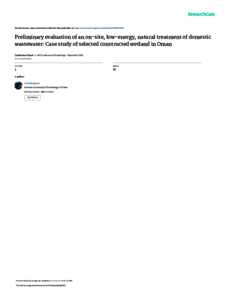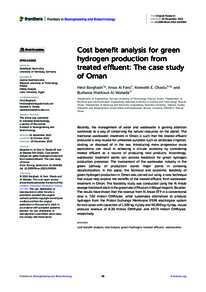Document
Preliminary evaluation of an on-site, low-energy, natural treatment of domestic wastewater : case study of selected constructed wetland in Oman.
Identifier
DOI: 10.1063/5.0068881
Source
AIP Conference Proceedings. v. 2409, 020008
Country
United States.
City
Maryland
Publisher
American Institute of Physics Inc.
Gregorian
2021-12-10
Language
English
Subject
English abstract
Oman is one of the countries with the least rainfall in the world. In its most urbanized region along the northern coast precipitation is around 100 mm per year. Water resources are scarce and forecasts of climate change over the next decades indicate that in this region rainfalls will decrease, and temperatures will increase. Potable water will still have to be sourced from water desalination processes, but water for other purposes, such as irrigating urban greenery as a heat protection for the built environment or growing biomass for energy supply can be sourced from treated wastewater. Water must be secured from possible recycled process; e.g. water reuse after proper treatment to accommodate the demand due to limited supply. This paper looks at one such treatment system for domestic wastewater in Oman. The constructed wetland - an on-site, low-energy, low-maintenance, horizontal flow, natural water treatment/ management system - built for the selected Ecohaus serves as a case study to assess the performance of the system and the quality of the effluent water output against the benchmark (MD 145/93 and RD 115/2001). After one month of running the constructed wetland, samples were collected from influent and effluent water once a week during one month (8 samples). The water quality was assessed regarding the parameter of Biochemical Oxygen Demand (BOD), Chemical Oxygen Demand (COD), Total Solids (TS), Total Suspended Solids (TSS), Total Dissolved Solids (TDS), Total Coliform (TC), and E-coli. the results show that the constructed wetland of the selected EcoHaus performs excellently. That describes the develop of microorganism in the constructed wetland system with time. While, the average percentage removal rates of BOD, COD, TS, TSS, TDS, TC, and E-Coli are 76.9,82.7,35.9,86.8,7.3, 48.4, and 48 respectively. The paper concludes with a possible optimization of the constructed wetland and an outlook onto a possible large-scale application of such decentralized natural water treatment plants in an urban setting in Oman.
ISSN
0094-243X
Category
Journal articles


